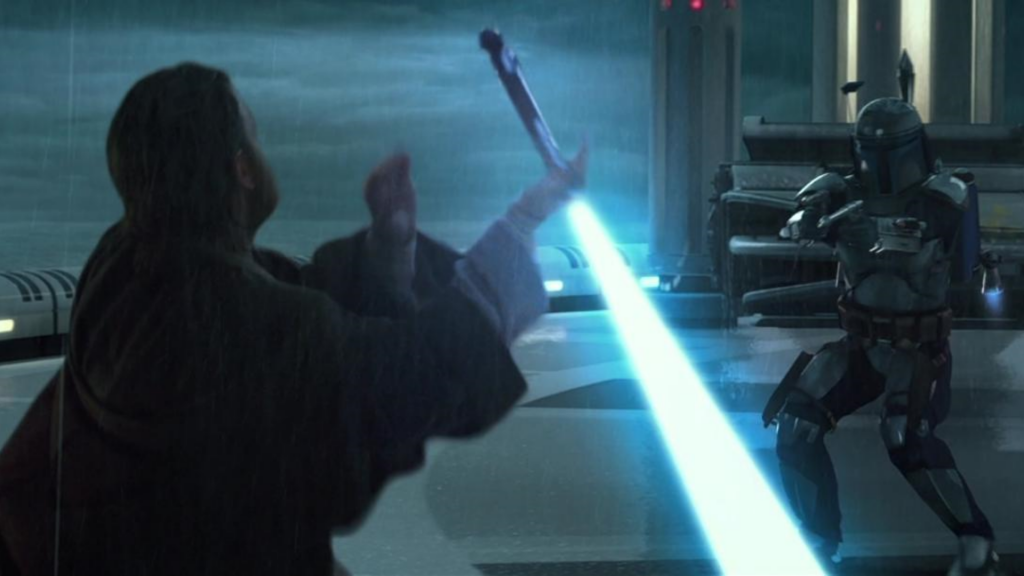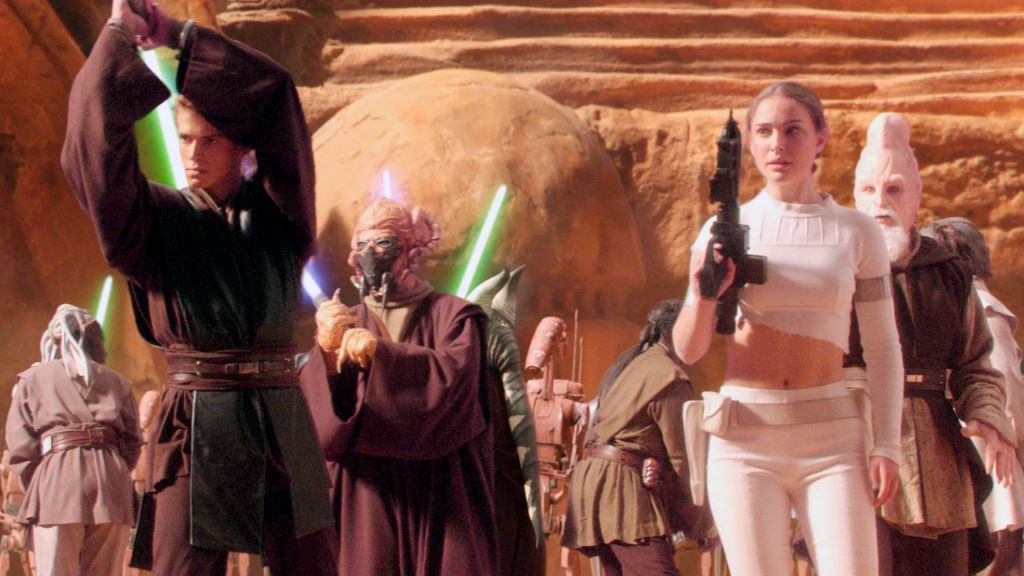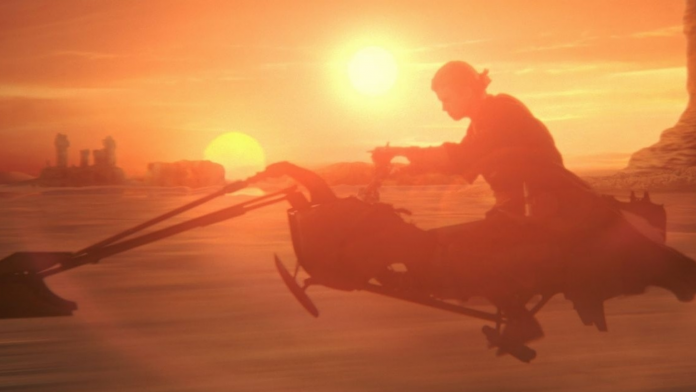Star Wars: Episode II – Attack of the Clones had its worldwide premiere 20 years ago today. Despite it being the weakest entry in the prequel trilogy, history has been kind to the political epic.
Whilst there is a heavy reliance on computer generated imagery (CGI) and the dialogue holds it back, looking back it has improved over time, with its better characters and cooler fight scenes. This film also started the conflict known as The Clone Wars. Whilst the next film would not explore this conflict in great detail, it allowed acclaimed spin-offs and TV series to be created in its wake, such as Star Wars: Clone Wars, Star Wars: The Clone Wars, and more recently The Bad Batch.
First, the negative. Whilst the CGI does allow for the creation of new worlds and districts such as the low levels of Coruscant, the rocky terrain and flowing deserts of Geonosis, and the rain soaked cities of Kamino, these come with drawbacks. Sequences like the Droid Factory and the Battle of Geonosis come across like video game levels, with too much animation detracting from any sense of atmosphere. The latter has a particular problem, as it is quite hard to become attached to the clones as they are presented. The battle itself is far from perfect, with too much going on. George Lucas himself seemed to realise this, as early into The Clone Wars the show revisited the planet and ‘replayed’ the battle, only with clearer characters and a stronger narrative focus. The Clone Wars also addressed the blank nature of the clones by giving them a unique identity, allowing the audience to form a connection with them.

Attack of the Clones revolves around two central plots; the royally mocked, wooden romance of Anakin Skywalker (Hayden Christensen) and Padmé Amidala (Natalie Portman), and the gripping investigation conducted by Obi-Wan Kenobi (Ewan McGregor). This leads him to stumble upon the film’s best additions to the Star Wars lore— Kamino and Jango Fett (Temuera Morrison). While his introduction and the revelation that cult favourite character Boba Fett is a clone of his ‘father’ is a clumsy retcon, Star Wars has had a plethora of these in the Disney era, and not all of them are as cool. His fight against Obi-Wan demonstrated the devastating potential of Mandalorian armour and weaponry, which is still being explored today courtesy of The Mandalorian. Fett’s ship, Slave One, became the stuff of legend thanks in no small part to its iconic sound effects. The fight in Geonosis’ asteroid field gave a one-on-one ship duel that hasn’t been replicated since, even in the sequel era. His death is better handled than his son’s in Star Wars: Episode VI – Return of the Jedi, though a similar feeling of wasted potential is felt. Jango would have made for an interesting antagonist for the clones, exploring their identity by pitting them against their creator.
The dialogue between Skywalker and Amidala is stilted, with the scene by the fireside on Naboo for instance featuring some of the hardest dialogue to sit through. Padmé herself however is a strong character. She is stubborn in the face of several assassination attempts, and holds strong convictions in her negotiation skills to avoid war. But when war does break out, she does not cower from her duties. An interaction between her and a clone proves this, with her refusing to run despite being shot from her gunship. Despite this, there are moments where Padmé is either sexualised or cast into a more passive role, acting purely as a vehicle for Anakin’s passion or aggression. Star Wars: Episode III – Revenge of the Sith continues the worst of this, giving Padmé very little to do apart from be bare-foot and pregnant.
Even so, this is still superior to what the sequels do with their female characters. Rose (Kelly Marie Tran) has an underdeveloped love story with Finn, and her character is then completely side-lined in Star Wars: Episode IX – The Rise of Skywalker, preventing this love from being developed. Rey (Daisy Ridley) fairs better than Rose, but her obsession with her parentage and how it will give her a sense of self becomes a core part of her character. This culminates in a deeply unsatisfying resolution. Padmé does not hinge her greatness on her name nor does her being start and stop with her true love. She was elected queen at fourteen and is then asked to stand as Senator. Her name does not destine her for these things, but her sense of duty. Whilst Padme’s character is not perfect, her character is more inspiring than either Rey or Rose.

Attack of the Clones surpasses the sequels in other areas too. It has a coherent place within its own trilogy, unlike its sequel counterparts. The opening crawl helps set the context, catching audiences up so they know how it relates to Star Wars: Episode I – The Phantom Menace. Elements that were set up in that film, such as Palpatine’s rise to power and Anakin’s ascent under Obi-Wan, are paid off and continued, instead of being dropped by the wayside. This galactic conflict is largely glossed over in Revenge of the Sith, with only the last few battles being covered. However, this does not affect the coherence of the trilogy, as it continues the same storylines and themes—themes that in Attack of the Clones are conveyed in a much more subtle and natural way, unlike the glaringly obvious subtext of The Last Jedi.
Attack of the Clones‘ introduction and elaboration of key elements of the Star Wars canon has also gone down well since their introduction. Whilst Count Dooku (Christopher Lee) receiving the plans for the Death Star originally felt forced, new canon material has given new meaning to this moment. Rogue One: A Star Wars Story and its prequel, the book Catalyst: A Rogue One Novel, explores in great detail the creation of the Death Star, touching on the Geonosian connection and improving it. Now, this moment conjures the intricate string of deceit that led to the Death Star’s creation in the audience’s mind, replacing the originally forced connection.
While the overused CGI and poor dialogue hold the film back, there are enjoyable elements upon a rewatch. The investigation conducted by Obi-Wan results in the coolest character in the film, and when compared to the sequel films its character and thematic coherence make Attack of the Clones a film that is still worth your time. Finally, if nothing else, the fan driven meme community has added an element of unintentional humour, which makes the film a joy to watch.
Words by Kieran Burt
Support The Indiependent
We’re trying to raise £200 a month to help cover our operational costs. This includes our ‘Writer of the Month’ awards, where we recognise the amazing work produced by our contributor team. If you’ve enjoyed reading our site, we’d really appreciate it if you could donate to The Indiependent. Whether you can give £1 or £10, you’d be making a huge difference to our small team.
